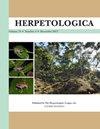幼颈蜥(Crotaphytus collaris)何时首次与雌性交配并受精?
IF 1.1
3区 生物学
Q2 ZOOLOGY
引用次数: 0
摘要
摘要:在许多物种中,雄性比雌性体型更大、颜色更鲜艳。这通常是由性选择进化而来的,一旦个体成年,就会观察到性二态性和二态性。这种性别差异表现在领蜥蜴、领蛙身上。然而,与成年人不同的性二重性在青少年第一次性交前就已经出现了。晚熟季节的幼年雄性会发育出明亮的橙色背外侧条纹,并开始保卫领地,与雌性形成配对关系。此外,最大的、季节较晚的、被认为是幼年雄性的半萜上有成熟的精子。使用聚合酶链式反应对8个微卫星基因座进行的亲子关系分析显示,大量假定的幼年雄性在第二年我们的研究地点的密集实地调查中没有发现,它们在秋季与幼年、一岁或成年的雌性交配。雌性要么在秋天被这些雄性受精(这些雌性要么储存精子,要么在越冬时阻止胚胎发育),要么在第二年春天早些时候被幸存的秋季幼年雄性(即一岁大的幼崽)受精,它们随后在我们开始春夏实地调查之前死亡。我们的大部分数据表明第二种可能性是真的。首先,成年和一岁的男女都会在秋季,即10月前的几周或几个月开始交配,此时体型较大的假定成年雄性表现出性二色性,并且其半萜上有成熟的精子。这些年龄段的雌性在十月不能交配,但在早春。其次,我们在10月份从野外采集了幼年雌性,并在实验室中对它们进行了单独饲养,整个春季和夏季都不接触雄性。这些雌性都没有怀孕。我们的研究结果表明,尽管假定的幼年雄性在深秋拥有成熟精子,但它们要等到第二年春天才能让所有年龄段的成年人受精。这些雄性中的许多随后在季节早期死亡,但在一岁大的雄性和成年雄性完全占据领地并性活跃之前,通过在春季早期交配来达到(死后)健康。本文章由计算机程序翻译,如有差异,请以英文原文为准。
When do Young Collared Lizards (Crotaphytus collaris) First Copulate with and Fertilize Females?
Abstract: In many species, males are larger and more colorful than females. This has often evolved by sexual selection, and the sexual dimorphism and dichromatism is observed once individuals reach adulthood. Such sexual differences are presented by Collared Lizards, Crotaphytus collaris. However, sexual dichromatism of a different sort than that expressed in adults is seen in juveniles before their first brumation. Late-season juvenile males develop bright orange dorsolateral bars and begin to defend territories and form pair bonds with females. Furthermore, the largest, late-season, putative juvenile males have mature sperm on their hemipenes. Paternity analyses using polymerase chain reaction of eight microsatellite loci revealed that a significant number of putative juvenile males, which were not seen during intensive fieldwork at our study site the following year, sired offspring with females who were juveniles, yearlings, or adults in the fall. Either females were fertilized by these males in the fall (and those females either stored sperm or arrested development of embryos overwinter), or they were fertilized by surviving fall juvenile males (i.e., yearlings) early the next spring, who subsequently died before we began our spring-summer field surveys. The majority of our data indicates the second possibility is true. First, adults and yearlings of both sexes begin brumation in the fall, weeks or months before October when larger putative juvenile males display sexual dichromatism and have mature sperm on their hemipenes. Females of these age classes are not available for copulation in October but are in early spring. Second, we collected juvenile females from the field in October and held them individually without exposure to males in the laboratory through brumation and beyond through spring and summer. None of these females became gravid. Our results indicate that although putative juvenile males possess mature sperm in the late fall, they wait until the following spring to fertilize adults of all age classes. Many of these males subsequently die early in the season but attain (posthumous) fitness by mating early in the spring before yearling and adult males become fully territorial and sexually active.
求助全文
通过发布文献求助,成功后即可免费获取论文全文。
去求助
来源期刊

Herpetologica
生物-动物学
CiteScore
4.60
自引率
0.00%
发文量
27
审稿时长
>12 weeks
期刊介绍:
Established in 1936, Herpetologica is a quarterly peer-reviewed journal serving herpetologists, biologists, ecologists, conservationists, researchers and the scientific community. The journal contains original research papers and essays about the biology of reptiles and amphibians, and covers many relevant topics including: behavior, conservation, ecology, genetics, morphology, physiology and taxonomy.
 求助内容:
求助内容: 应助结果提醒方式:
应助结果提醒方式:


